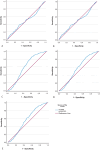Research Communication: Breath Testing for Colorectal Cancer Detection in Patients With a Positive Fecal Immunochemical Test: A Multicentre Prospective Cross-Sectional Study With External Validation
- PMID: 40459533
- PMCID: PMC12203142
- DOI: 10.1111/apt.70207
Research Communication: Breath Testing for Colorectal Cancer Detection in Patients With a Positive Fecal Immunochemical Test: A Multicentre Prospective Cross-Sectional Study With External Validation
Abstract
Colorectal cancer (CRC) screening using fecal immunochemical tests (FIT) is suboptimal. This multicentre study evaluated an electronic nose (e-nose) for CRC detection in FIT-positive patients, along with reproducibility and external validation. Among 3469 participants (40.1% female, median age 64.3y), CRC was diagnosed in 5.0%; 25.1% had a normal colonoscopy. The e-nose showed poor diagnostic performance (AUC 0.542; sensitivity 39.5%; specificity 68.3%) and low reproducibility (ICC 0.22). Despite high patient acceptability (95.3% willingness-to-repeat), these findings suggest e-nose technology is not yet ready for clinical implementation. Further research is needed to standardise and validate e-nose devices before supplementing current screening methods. Clinicaltrials.gov Identifier NCT03346005 and NCT04357158.
Keywords: colonoscopy; colorectal cancer; electronic nose; screening; surveillance; volatile organic compounds.
© 2025 The Author(s). Alimentary Pharmacology & Therapeutics published by John Wiley & Sons Ltd.
Conflict of interest statement
This study is investigator‐initiated and was funded by the Dutch Digestive Foundation (MLDS) and European Union (EFRO). The e‐nose devices (Aeonose, the eNose company, Zutphen, the Netherlands) were provided by the manufacturer for this study without cost.
Author P.S. receives unrestricted grants from Pentax (Japan), FujiFilm (Japan), Norgine (UK), MicroTech (China) and Magentiq Eye (Israel) and is on the advisory board of Sanofi (The Netherlands). Medical Specialists Company Isala (MSB Isala) invested in the eNose Company, Zutphen, the Netherlands. Author W.d.V.t.N.C. is a member of the MSB but declared to renounce potential future profits of the eNose Company in person. Authors M.R., K.K., A.T. and R.S. declare no competing interests.
Figures
References
-
- van Keulen K. E., Jansen M. E., Schrauwen R. W. M., Kolkman J. J., and Siersema P. D., “Volatile Organic Compounds in Breath Can Serve as a Non‐Invasive Diagnostic Biomarker for the Detection of Advanced Adenomas and Colorectal Cancer,” Alimentary Pharmacology & Therapeutics 51, no. 3 (2020): 334–346. - PMC - PubMed
-
- Chandrapalan S., Bosch S., Cubiella J., et al., “Systematic Review With Meta‐Analysis: Volatile Organic Compound Analysis to Improve Faecal Immunochemical Testing in the Detection of Colorectal Cancer,” Alimentary Pharmacology & Therapeutics 54, no. 1 (2021): 14–23. - PubMed
-
- Leopold J. H., Bos L. D., Sterk P. J., et al., “Comparison of Classification Methods in Breath Analysis by Electronic Nose,” Journal of Breath Research 9, no. 4 (2015): 046002. - PubMed
-
- Woodfield G., Belluomo I., Laponogov I., Veselkov K., Cross A. J., and Hanna G. B., “Diagnostic Performance of a Noninvasive Breath Test for Colorectal Cancer: COBRA1 Study,” Gastroenterology 163, no. 5 (2022): 1447, e8–1449. - PubMed
Publication types
MeSH terms
Associated data
Grants and funding
LinkOut - more resources
Full Text Sources
Medical

